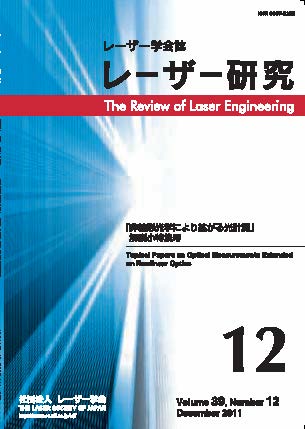All issues

Volume 44, Issue 12
Special Issue on Recent Progress in Laser Material Processing Supported by Numerical Simulations
Displaying 1-8 of 8 articles from this issue
- |<
- <
- 1
- >
- >|
Special Issue on Recent Progress in Laser Material Processing Supported by Numerical Simulations
Special Issue
Laser Review
-
Masaki HASHIDA2016Volume 44Issue 12 Pages 782-
Published: 2016
Released on J-STAGE: December 17, 2020
JOURNAL FREE ACCESSDownload PDF (221K) -
Kenichi L. ISHIKAWA, Takeshi SATO2016Volume 44Issue 12 Pages 784-
Published: 2016
Released on J-STAGE: December 17, 2020
JOURNAL FREE ACCESSWe review, among major ab initio wave-function-based numerical approaches, time-dependent multiconfiguration self-consistent-field (TD-MCSCF) methods to simulate multielectron dynamics in atoms and molecules driven by intense long-wavelength and/or ultrashort short-wavelength laser pulses. This class of first-principles approaches offers a flexible framework from which a variety of methods can be derived with the possibility to systematically control the accuracy. Here we specifically introduce time-dependent configuration interaction (TDCI), multiconfiguration time-dependent Hartree-Fock (MCTDHF), and time-dependent complete active-space self-consistent field (TD-CASSCF) methods. We also show representative numerical results.View full abstractDownload PDF (469K) -
Kazuhiro YABANA2016Volume 44Issue 12 Pages 789-
Published: 2016
Released on J-STAGE: December 17, 2020
JOURNAL FREE ACCESSWe develop a first-principles computational approach for dynamics of electrons and optical fields in crystalline solids that will be useful to explore initial stages of nonthermal laser processing of dielectrics. In the method, we describe atomic-scale electron dynamics in dielectrics induced by an intense and ultrashort laser pulse based on time-dependent density functional theory. Combining the electron dynamics calculation with Maxwell equations that describe propagation of the laser pulse, we evaluate the energy transfer from the laser pulse to electrons in the dielectrics without any empirical parameters. Comparing the energy transfer with the cohesive energy and the heat of fusion of the dielectrics, we estimate threshold and depth of laser ablation.View full abstractDownload PDF (655K) -
Hitoshi SAKAGAMI2016Volume 44Issue 12 Pages 794-
Published: 2016
Released on J-STAGE: December 17, 2020
JOURNAL FREE ACCESSIt was found in many experiments that repeated irradiations of short pulse lasers could form periodic nano-structures on metal surfaces and many formation mechanisms were suggested, but it is not fully understood yet. Therefore we use the two-dimensional PIC (Particle-In-Cell) code, in which equations of motion for charged particles and Maxwell equations for electromagnetic fields are simultaneously computed in two-dimensional space and three-dimensional velocity space, to simulate laser-plasma interactions and to investigate the formation mechanism of the nanostructure. When the laser intensity is relativistic, magnetic field and current density develop typical structures of the Weibel instability and it is found that this instability plays an important role to form the periodic nano-structure. On the other hand, it is also found that bi-directional surface plasma waves play a significant role together with the oscillating two-stream instability in the case of non-relativistic laser intensity.View full abstractDownload PDF (1939K) -
Toshiharu MURAMATSU2016Volume 44Issue 12 Pages 799-
Published: 2016
Released on J-STAGE: December 17, 2020
JOURNAL FREE ACCESSA general-purpose three-dimensional thermohydraulics numerical simulation code SPLICE (residual Stress control using Phenomenological modeling for Laser welding repair process In Computational Environment) was developed at JAEA (Japan Atomic Energy Agency) and designed to deal with gasliquid- solid consolidated incompressible viscous flows with a phase change process in various laser applications, such as welding, coating, cutting, piercing, etc. The result obtained from laser coating simulations is very encouraging in the sense that the SPLICE code would be used as one of efficient tools for a front-loading realization, an irradiation condition provision, etc. in related to the laser coating processes.View full abstractDownload PDF (1850K) -
Keisuke YAHATA, Seiji SHIMIZU, Masanao MURAKAMI2016Volume 44Issue 12 Pages 804-
Published: 2016
Released on J-STAGE: December 17, 2020
JOURNAL FREE ACCESSScribing, or the full-body cutting of glass substrates, can be achieved by thermal stress that is induced by laser heating. In such processing, the substrate’s temperature distribution is controlled by scanning the heat source or a pair of heat and cooling sources for generating sufficiently high tensile stress to propagate a crack. As a result of crack propagation that follows the laser beam, the substrate can be divided along the laser beam scanning path. By analyzing the temperature and the thermal stress in the numerical simulations, we can estimate suitable processing conditions. How the crack propagates can also be estimated by analyzing the stress intensity factors. Numerical simulations supported clarifying the mechanism of crack propagation and devising new processing methods for controlling crack propagation.View full abstractDownload PDF (1019K) -
Mitsuhiro TERAKAWA, Atsuhiro ISHII2016Volume 44Issue 12 Pages 809-
Published: 2016
Released on J-STAGE: December 17, 2020
JOURNAL FREE ACCESSThe use of small particles has expanded the capability of ultrafast laser processing and provides precise processing in nanometer-scale space that overcomes the theoretical diffraction-limited spatial resolution. Recently precise laser processing is showing attractive developments in biomedical applications including drug delivery and cell stimulation. This review gives the fundamentals of laser processing by enhanced optical fields and its calculational studies. We also describe the recent progresses in bioapplications that use femtosecond lasers and small particles.View full abstractDownload PDF (703K)
Laser Original
-
Tomomasa OHKUBO, Yuji SATO, Ei-ichi MATSUNAGA, Masahiro TSUKAMOTO2016Volume 44Issue 12 Pages 814-
Published: 2016
Released on J-STAGE: December 17, 2020
JOURNAL FREE ACCESSAlthough carbon fiber reinforced plastic (CFRP) is widely used for several applications, the heat affected zone (HAZ) by laser processing decreases the cutting quality. We performed experiments and discussed both matrix evaporation zone (MEZ) and resin alteration zone (RAZ) in the previous study. In this paper, we performed numerical simulation of CFRP’s laser processing and simulated laser ablation as high temperature and high pressure of compressive gas. We calculated the heat flux to the material surface from numerical simulation results and propose a model that explains how the MEZ and RAZ are created. In this model, RAZ is mainly created when the depth of the processed hole is shallow and MEZ is mainly created after the depth is increased.View full abstractDownload PDF (561K)
- |<
- <
- 1
- >
- >|